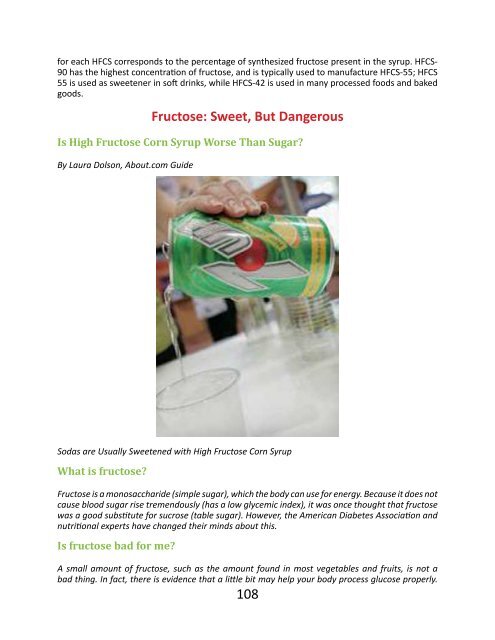Create successful ePaper yourself
Turn your PDF publications into a flip-book with our unique Google optimized e-Paper software.
for each HFCS corresponds to the percentage of synthesized fructose present in the syrup. HFCS-<br />
90 has the highest concentration of fructose, and is typically used to manufacture HFCS-55; HFCS<br />
55 is used as sweetener in soft drinks, while HFCS-42 is used in many processed foods and baked<br />
goods.<br />
<strong>Fructose</strong>: Sweet, But Dangerous<br />
Is High <strong>Fructose</strong> Corn Syrup Worse Than Sugar?<br />
By Laura Dolson, About.com Guide<br />
However, consuming too much fructose at once seems to overwhelm the body's capacity to process<br />
it. The diets of our ancestors contained only very small amounts of fructose. These days, estimates<br />
are that about 10% of the modern diet comes from fructose.<br />
What happens if I consume too much fructose?<br />
Most of the carbohydrates we eat are made up of chains of glucose. When glucose enters<br />
the bloodstream, the body releases insulin to help regulate it. <strong>Fructose</strong>, on the other hand,<br />
is processed in the liver. To greatly simplify the situation: When too much fructose enters the<br />
liver, the liver can't process it all fast enough for the body to use as sugar. Instead, it starts<br />
making fats from the fructose and sending them off into the bloodstream as triglycerides.<br />
Why is this bad?<br />
This is potentially bad for at least three reasons:<br />
• High blood triglycerides are a risk factor for heart disease.<br />
• Corn <strong>Fructose</strong> ends up circumventing the normal appetite signaling system, so appetiteregulating<br />
hormones aren't triggered--and you're left feeling unsatisfied. This is probably at<br />
least part of the reason why excess fructose consumption is associated with weight gain.<br />
• There is growing evidence that excess fructose consumption may facilitate insulin resistance,<br />
and eventually type 2 diabetes. However, Most of this effect may be from chemicals in soda<br />
which reacts with the high fructose corn syrup.<br />
What are the major sources of fructose?<br />
Fruits and vegetables have relatively small, "normal" amounts of fructose that most bodies can<br />
handle quite well. The problem comes with added sugars in the modern diet, the volume of which<br />
has grown rapidly in recent decades. The blame has often been pinned to high fructose corn syrup<br />
(HFCS), which is made up of 55% fructose and 45% glucose. However, sucrose is half fructose and<br />
half glucose. So, HFCS actually doesn't have a whole lot more fructose than "regular" sugar, gram<br />
for gram.<br />
Sodas are Usually Sweetened with High <strong>Fructose</strong> Corn Syrup<br />
What is fructose?<br />
<strong>Fructose</strong> is a monosaccharide (simple sugar), which the body can use for energy. Because it does not<br />
cause blood sugar rise tremendously (has a low glycemic index), it was once thought that fructose<br />
was a good substitute for sucrose (table sugar). However, the American Diabetes Association and<br />
nutritional experts have changed their minds about this.<br />
Is fructose bad for me?<br />
High fructose corn syrup has become incredibly inexpensive and abundant, partially due to corn<br />
subsidies in the United States. So, really, the problem is more that it has become so cheap that it<br />
has crept its way into a great number of the foods we eat every day.<br />
Chemical properties<br />
<strong>Fructose</strong> is a 6-carbon polyhydroxyketone. It is an isomer of glucose, i.e. both have the same<br />
molecular formula (C6H12O6), but they differ structurally. Crystalline fructose adopts a cyclic sixmembered<br />
structure owing to the stability of its hemiketal and internal hydrogen-bonding. This<br />
form is formally called D-fructopyranose. In solution, fructose exists as an equilibrium mixture of<br />
70% fructopyranose and about 22% fructofuranose, as well as small amounts of the three other<br />
forms, including the acylic structure.<br />
A small amount of fructose, such as the amount found in most vegetables and fruits, is not a<br />
bad thing. In fact, there is evidence that a little bit may help your body process glucose properly.<br />
108 109

















